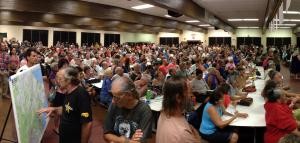‘Restless’ Volcano Study to Include Kilauea
The National Science Foundation will provide the University of Hawai’i at Manoa with $1.2 million in funding as part of a six-university collaboration with the Volcano Hazards Program of the United States Geological Survey, studying volcanic crises at Kilauea, as well as at Long Valley in California.
“The goal is to improve our relationship with ‘restless,’ potentially dangerous, active volcanoes in the United States,” said Kilauea project lead Bruce Houghton, the Gordon A. Macdonald Professor of Volcanology at UHM and Hawai‘i State Volcanologist. “Moderate to large volcanic eruptions in this country are infrequent but long-lasting and high-consequence events with multiple hazards.”
Houghton, who along with geologist Chris Gregg and Professor Karl Kim will lead the project at UHM’s National Disaster Preparedness Training Center, says that volcanic crises have a swarm of volcanological, engineering, human, planning human, planning and economic issues. These issues, he says, have very high levels of uncertainty in all types of data.

Crowded public meeting held in Pahoa by officials from County of Hawaii and USGS HVO. Photo credit: USGS.
“The uncertainties in how the volcano, the community and decision-making institutions will behave can turn events into crises and sometimes disasters,” noted Houghton.
As a result of the costs of volcanic crises, they are often out of proportion compared to the magnitude of the parent eruption.
Scientist-in-Charge at the USGS Hawaiian Volcano Observatory, Christina Neal, emphasized the excitement revolving around the program not only for science based insights but also for communication improvements.
“This exciting, multi-disciplinary program will provide important new insights into how hazardous volcanic processes and complex volcanic systems behave,” said Neal. “Moreover, the integration of this scientific understanding with results from novel social science investigations will improve the ways we communicate information to those at risk.”
A main emphasis point of the project is in the recruitment of graduate students and young researchers who may be interested in interdisciplinary hazard research, and to mold them into the next generation of volcanologists and hazard researchers in the United States.
Researcher “in training” so to speak, will spend time split between a home university and either USGS HVO or the USGS California Volcano Observatory in Menlo Park, California.
Interactions with state and county management, and the Federal Emergency Management Agency will be linked into the project. The study will also strengthen the partnership between the USGS HVO and the UHM Department of Geology and Geophysics.
The study composed of seven institutions will be led by the University at Buffalo, and will also include the University of California – Berkeley, University of Washington, Duke and Marquette Universities, along with UHM and USGS.
















